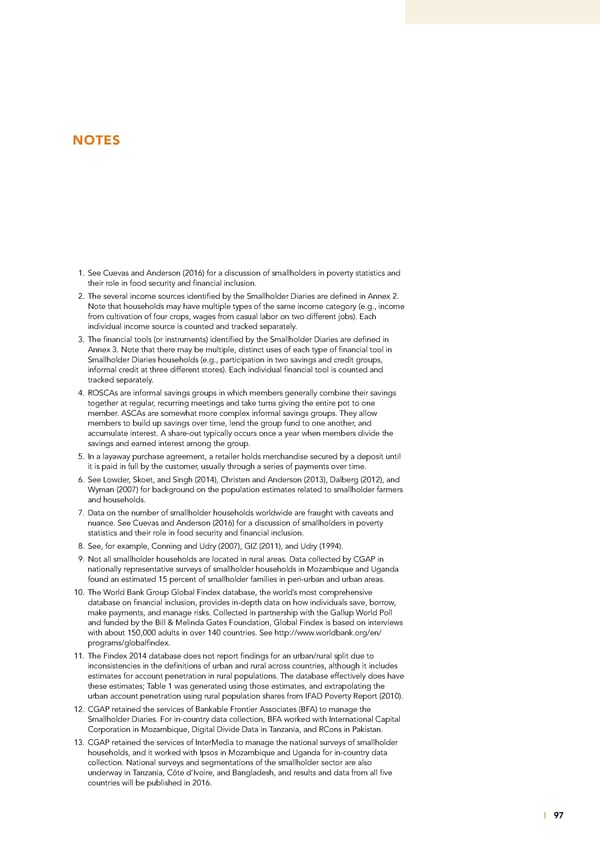NOTES 1. See Cuevas and Anderson (2016) for a discussion of smallholders in poverty statistics and their role in food security and financial inclusion. 2. The several income sources identified by the Smallholder Diaries are defined in Annex 2. Note that households may have multiple types of the same income category (e.g., income from cultivation of four crops, wages from casual labor on two different jobs). Each individual income source is counted and tracked separately. 3. The financial tools (or instruments) identified by the Smallholder Diaries are defined in Annex 3. Note that there may be multiple, distinct uses of each type of financial tool in Smallholder Diaries households (e.g., participation in two savings and credit groups, informal credit at three different stores). Each individual financial tool is counted and tracked separately. 4. ROSCAs are informal savings groups in which members generally combine their savings together at regular, recurring meetings and take turns giving the entire pot to one member. ASCAs are somewhat more complex informal savings groups. They allow members to build up savings over time, lend the group fund to one another, and accumulate interest. A share-out typically occurs once a year when members divide the savings and earned interest among the group. 5. In a layaway purchase agreement, a retailer holds merchandise secured by a deposit until it is paid in full by the customer, usually through a series of payments over time. 6. See Lowder, Skoet, and Singh (2014), Christen and Anderson (2013), Dalberg (2012), and Wyman (2007) for background on the population estimates related to smallholder farmers and households. 7. Data on the number of smallholder households worldwide are fraught with caveats and nuance. See Cuevas and Anderson (2016) for a discussion of smallholders in poverty statistics and their role in food security and financial inclusion. 8. See, for example, Conning and Udry (2007), GIZ (2011), and Udry (1994). 9. Not all smallholder households are located in rural areas. Data collected by CGAP in nationally representative surveys of smallholder households in Mozambique and Uganda found an estimated 15 percent of smallholder families in peri-urban and urban areas. 10. The World Bank Group Global Findex database, the world’s most comprehensive database on financial inclusion, provides in-depth data on how individuals save, borrow, make payments, and manage risks. Collected in partnership with the Gallup World Poll and funded by the Bill & Melinda Gates Foundation, Global Findex is based on interviews with about 150,000 adults in over 140 countries. See http://www.worldbank.org/en/ programs/globalfindex. 11. The Findex 2014 database does not report findings for an urban/rural split due to inconsistencies in the definitions of urban and rural across countries, although it includes estimates for account penetration in rural populations. The database effectively does have these estimates; Table 1 was generated using those estimates, and extrapolating the urban account penetration using rural population shares from IFAD Poverty Report (2010). 12. CGAP retained the services of Bankable Frontier Associates (BFA) to manage the Smallholder Diaries. For in-country data collection, BFA worked with International Capital Corporation in Mozambique, Digital Divide Data in Tanzania, and RCons in Pakistan. 13. CGAP retained the services of InterMedia to manage the national surveys of smallholder households, and it worked with Ipsos in Mozambique and Uganda for in-country data collection. National surveys and segmentations of the smallholder sector are also underway in Tanzania, Côte d’Ivoire, and Bangladesh, and results and data from all five countries will be published in 2016. | 97
 Financial Diaries with Smallholder Families Page 114 Page 116
Financial Diaries with Smallholder Families Page 114 Page 116